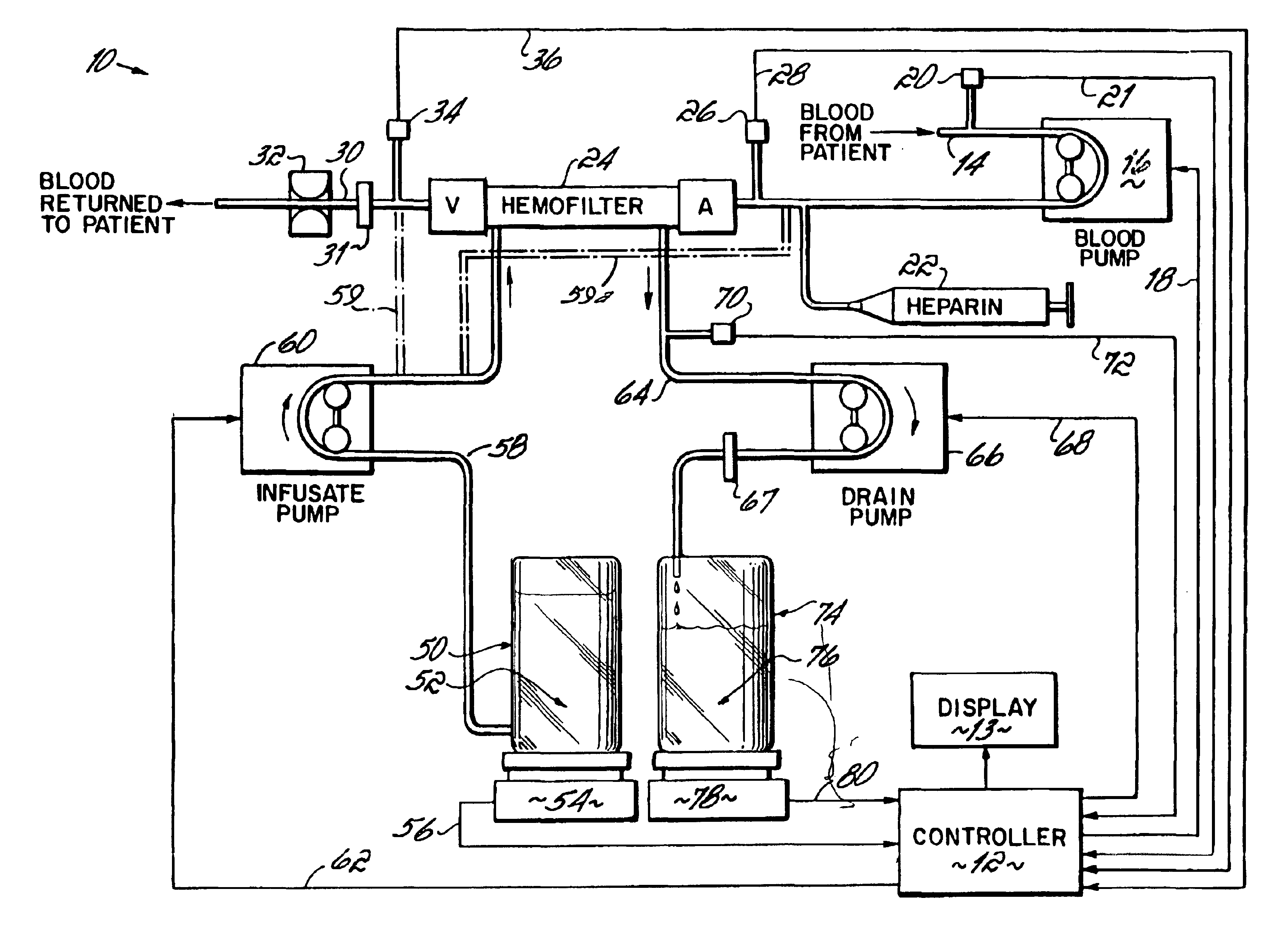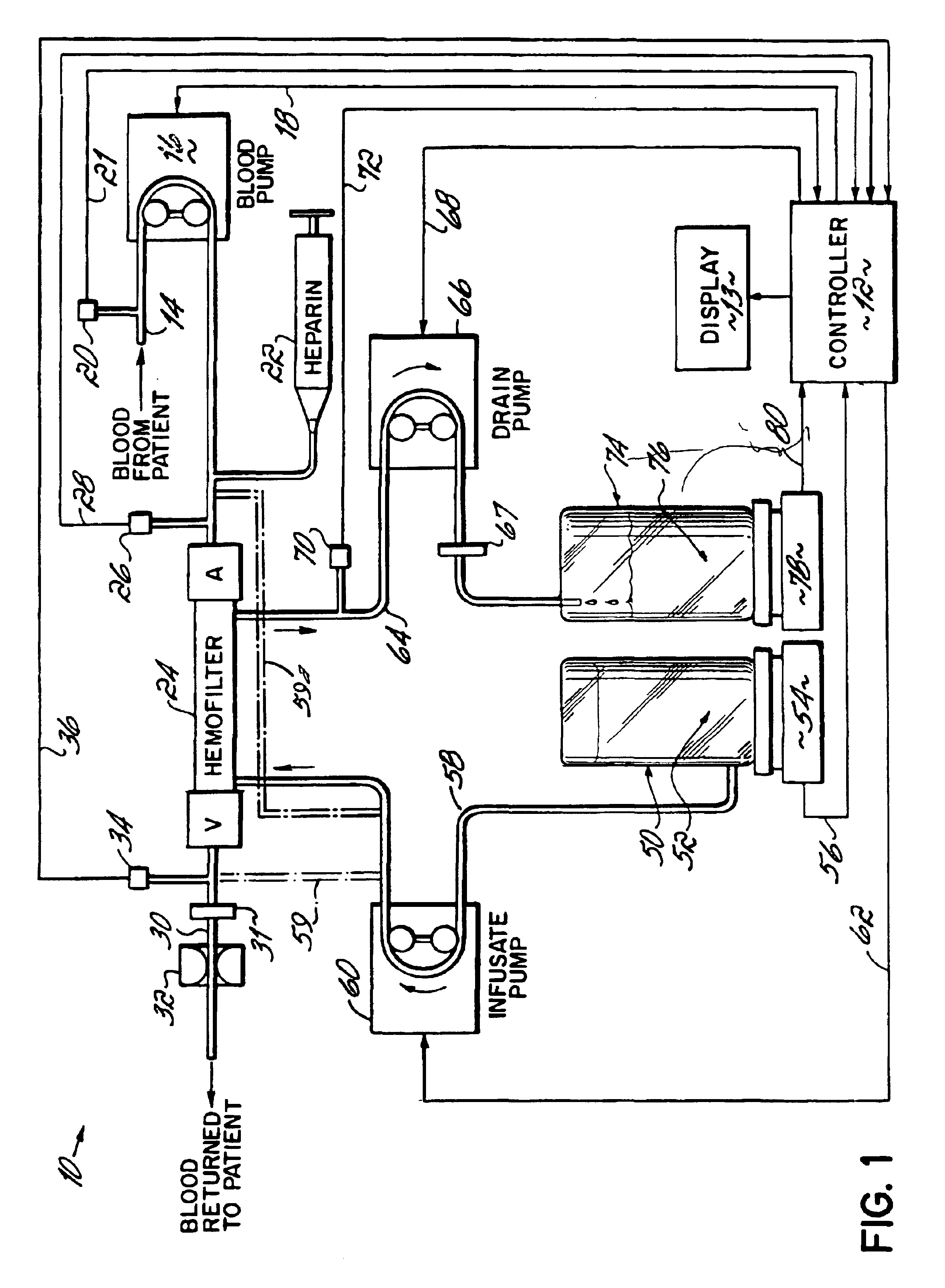Hemofiltration system
a filtration system and hematopoietic technology, applied in memory systems, feed/discharge, water/sewage treatment, etc., can solve the problems of lack of flexibility and accuracy required and the current system for monitoring and controlling renal replacement procedures lacks flexibility and accuracy to perform such procedures on neonates. , the effect of long-term operation, high degree of accuracy
- Summary
- Abstract
- Description
- Claims
- Application Information
AI Technical Summary
Benefits of technology
Problems solved by technology
Method used
Image
Examples
example 2
A ultrafiltration procedure lasting approximately one hour, with the blood flow rate set at 40.0 ml / min, the drain flow rate set to 230.0 ml / hr, and both replacement flow rates set to 100.0 ml / hr simulates an ultrafiltration procedure performed on a neonate. Typical flow rate and weight tracking errors of a simulation utilizing water as a substitute for all fluids are shown in FIGS. 8A, 8B, 8C and 8D. The blood pump tracking error at the beginning of this simulation differs in character from the beginning of the simulation shown in FIGS. 7A-7C because the flowmeter low pass filter choices provided by the manufacturer were not identical for this time period in the two simulations. Given the precise duration of the procedure, the expected ultrafiltration was 30.1 ml. The ultrafiltration measured by comparing the initial (269.3.+-.0.5 gr) and final weight (241.0.+-.0.5 gr) of the "patient" was 28.3.+-.0.7 gr, which results in a difference of 1.7.+-.0.7 ml from the desired ultrafiltrati...
example 3
FIGS. 9A, 9B, and 9C present a simulation where the scale is bumped twice and a tubing leak occurs. Threshold values for determining an incongruent weight change are given in Table 3.
A brief disturbance of a large magnitude is introduced at a n=10 (by placing a large weight on the scale and removing it), and the supervisory controller does not react. At n=60, a similar, smaller disturbance is introduced for a brief period, and again, the supervisory controller does not respond. At n=90, a similar small disturbance is introduced, but for a prolonged period. This simulates a leak in the tubing, and is a much smaller disturbance than is generally encountered when leaks occur during actual ultrafiltration procedures. The controller detects the incongruent weight change and decides, in this case, to discontinue ultrafiltration.
example 4
FIGS. 10A, 10B, and 10C show simulated patient data and the desired drain rate for a simulation of ultrafiltration performed on a neonate The patient heart rate and blood pressure are generated with computer software. The blood flow rate is set to 40 ml / min, and the replacement rates are both set to 100 ml / min. The thresholds for the heart rate are chosen as 90 bpm and 105 bpm, and the thresholds for the blood pressure are chosen as 70 mmHg and 95 mmHg. At the beginning of the simulation, R.sub.h and P.sub.b are within their normal ranges. Around n=40, R.sub.h rises to above the threshold while P.sub.b stays normal. The supervisory controller makes a correction due to the high heart rate and waits for a reaction. During an actual ultrafiltration procedure the supervisory controller would wait about 10 minutes before taking any other actions because of a high heart rate. For purposes of the simulation, the wait is shortened to about 30 seconds. The switch logic once again activates F...
PUM
| Property | Measurement | Unit |
|---|---|---|
| voltage | aaaaa | aaaaa |
| voltage | aaaaa | aaaaa |
| flow rates | aaaaa | aaaaa |
Abstract
Description
Claims
Application Information
 Login to View More
Login to View More - R&D
- Intellectual Property
- Life Sciences
- Materials
- Tech Scout
- Unparalleled Data Quality
- Higher Quality Content
- 60% Fewer Hallucinations
Browse by: Latest US Patents, China's latest patents, Technical Efficacy Thesaurus, Application Domain, Technology Topic, Popular Technical Reports.
© 2025 PatSnap. All rights reserved.Legal|Privacy policy|Modern Slavery Act Transparency Statement|Sitemap|About US| Contact US: help@patsnap.com



